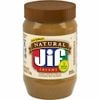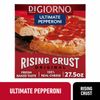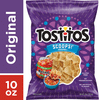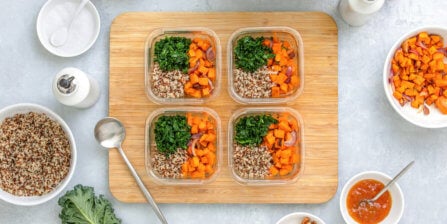Planning & Prep
10 Most Common Dietary Restrictions

Dietary restrictions are meal plans that limit or remove certain ingredients or whole categories of foods. The most common dietary restrictions may be associated with specific health issues, religious beliefs or physical intolerances, but some people simply choose to follow a certain diet due to their personal preferences.
In this post, we’ll examine some types of dietary restrictions and unique dietary approaches many choose to follow. We’ll also consider common allergies, foods limited by religious principles and dietary requirements associated with specific health matters. Maybe you’ll find out new facts about those diets you thought you understood all along, or learn about totally new ones. Let’s investigate!
1. Gluten intolerance or gluten sensitivity diet

The gluten protein is found in barley, wheat and rye flour, and it’s used in many dishes, such as bread, pizza crust and pasta. Unfortunately, some children and adults are allergic or sensitive to gluten. Celiac disease is associated with gluten intolerance but is not the same. Luckily, gluten-free products allow everyone to have multiple food options when planning gluten-free meals.
Main considerations:
- Most grocery stores have specific sections for gluten-free products.
- Read the labels! Make sure none of the ingredients list gluten products.
Product considerations:
Product swaps:
- Gluten-free flour for all-purpose flour
- Cauliflower crust for traditional pizza crust
2. Lactose intolerance diet

Those with lactose intolerance do not make enough lactase, a digestive enzyme, in their small intestine. This enzyme breaks down lactose, or “milk sugar,” in foods so your body can absorb its nutrients.
Those who are lactose intolerant may experience bloating, diarrhea or gas after eating or drinking milk products. Lactose intolerance is not a food allergy, but can cause some extreme discomfort in those that are intolerant.
Main considerations:
- Vitamin D and calcium in milk must be replaced with another non-dairy product, or lactose-intolerant people must take supplements.
- Replacing these vitamins and minerals is especially important in children and teenagers when calcium and other nutrients in milk are crucial for bone development.
- Lactose intolerance can be hereditary.
Product considerations:
Product swaps:
- Margarine made from oils instead of butter
- A tablespoon of vinegar in soy milk instead of buttermilk
- Plant-based cheeses instead of traditional cheese products
3. Vegetarian diet

People become vegetarians for various reasons, including their health, religious dietary restrictions or because they have concerns about animal welfare.
Vegetarianism can encompass a range of dietary patterns. For instance, lacto-ovo vegetarians do not eat meat of any kind, including seafood, but do consume eggs and dairy products. Lacto vegetarians don’t eat meat, seafood or eggs but do consume dairy.
Having a party with vegetarian friends? You don’t need to overlook anything to have a fully vegetarian menu with entrees, sides and even dessert!
Main considerations:
- Protein usually comes from nuts, legumes, soy products and seeds.
- Eat certain foods fortified with vitamin B12 or take a supplement.
Product considerations:
Product swaps:
- Mushroom steaks instead of beef burgers
- Hummus instead of dairy-based dips
- Tofurky instead of turkey
4. Vegan diet

Sometimes called “true vegetarians,” vegans eat nothing that comes from animal products, including red meat, fish, poultry, eggs, dairy products and even honey. A vegan diet is more strict than the typical vegetarian diet, as we’ve already discussed. Following this type of diet is strict and can make eating out difficult. Vegans need to know how everything is prepared so not to eat any animal byproduct used in the cooking process.
Main considerations:
- Ensure adequate protein intake through plant-based sources like beans, lentils, tofu, seeds and nut products.
- Calcium, vitamin B12, iodine, iron and selenium, essential nutrients in meats, must be replaced with plant-based items or dietary supplements.
Product considerations:
Product swaps:
- Jackfruit instead of chicken or pork
- Tempeh instead of bacon
- Falafel burgers instead of beef burgers
5. Kosher diet

Kosher describes foods that are compliant with specific Jewish dietary laws and restrictions, called “kashrut.” The rules associated with this diet define what kosher foods people are allowed to eat, how the food may be prepared, and what foods they can combine with others.
Main considerations:
- Meat, or “fleishig,” is anything made from meat or poultry. Only the blood-free forequarters of herbivores with cloven hooves can be eaten. Slaughtering, called “shechita,” is performed by a certified person known as a “shochet.”
- Dairy, or “milchig,” includes milk, cheese, butter and yogurt. These should never be eaten with meat. Kosher rules indicate that you must use separate utensils for each food type and cleanse them in different water.
- “Pareve” is any food that is not dairy or meat, including fish, eggs and plant-based foods.
Product considerations:
- Certified kosher foods will have a “K” inside a circle, star or triangle on their package.
- Certified kosher dairy foods will carry a logo with a “D” after the “K.”
- Certified kosher-neutral foods will have the word “pareve” after the kosher symbol or have a “U” in a circle.
- More stringent Jewish laws apply to Passover meals, which are marked with a “P.”
Product swaps:
- Kosher salt for iodized salt
- Kosher turkey bacon, uncured, natural instead of traditional bacon
6. Keto diet

The main objective of a keto diet is to move the body into ketosis by consuming high fat, modest protein and low carbohydrates.
Main considerations:
- Don’t eat any whole grains or starches.
- Don’t eat sugary foods.
- Don’t eat high-carb foods, including fruits or starchy veggies.
- Avoid low-fat diet products.
- Don’t drink alcohol.
Product considerations:
Product swaps:
- Cauliflower rice for traditional rice
- Zucchini noodles for traditional pasta noodles
- Stevia products instead of cane sugar
7. Halal diet

Halal food adheres to the laws of Islam, which come from the Quran. The meaning of halal is “lawful” or “permitted,” and those foods not permitted by Islamic dietary laws are called “haram.”
Main considerations:
- Avoid pork and any of its by-products, like gelatin.
- Avoid meat not slaughtered under Islamic dietary law.
- Avoid alcohol or anything prepared with alcohol or pure vanilla extract.
- Avoid foods containing any blood or blood byproducts.
- Avoid foods made with whey prepared with non-microbial enzymes, rennet, animal shortening, mono- and diglycerides from an animal, L-cysteine and sodium stearoyl lactylate.
Product considerations:
Product swaps:
- Sparkling seltzers instead of liquor
- Imitation vanilla flavoring instead of pure vanilla extract
- Vegetable shortening instead of lard
8. Pescetarian

The pescetarian diet is similar to a typically vegetarian diet but emphasizes seafood as an essential source of protein. Some pescatarians also eat eggs, dairy and other animal products. “Pesce” is the Italian word for fish, giving this diet or dietary restriction its name.
Product recommendations:
Product swaps:
- Fish tacos instead of a ground beef taco
- Plant-based hot dog instead of traditional beef ones
9. Paleo diet

The paleo or “paleolithic” diet involves eating meat and other foods hunted, gathered and eaten by early humans. You may consume meat, nuts, seeds and eggs, and fruits and vegetables are not limited unless they’re high in sugar or starch.
Main considerations:
- Most all carbohydrates are off-limits.
- Highly processed foods are restricted. Read labels to ensure the product does not contain refined sugar or dairy.
- Avoid dairy products, whole grains, legumes and starchy vegetables.
- No added salt or sugar is allowed.
Product considerations:
Product swaps:
- Unsweetened nut-based milk instead of cow’s milk
- Almond flour instead of traditional all-purpose flour
10. Dairy-free diet

Some people choose to be dairy-free due to religious restrictions, milk allergies or personal preference, while those suffering from lactose intolerance may choose to be dairy-free to deter uncomfortable digestive issues. Any of these is a good reason to follow a dairy-free diet, just don’t forget to make up for what they do best for our bodies.
Types of milk and other dairy products are filled with vitamins, protein and calcium our bodies need, but they’re not the only sources. Remember to replace these essentials with either a supplement or another food packed with these important ingredients.
Main considerations:
- When ordering in restaurants, ask if menu items contain dairy products. Certain foods may not be specifically designated as dairy-free.
Product considerations:
- Soy, almond or oat milk
- Fortified cereals and orange juice
Product swaps:
- Frozen juice bar as an ice cream alternative
- Plant-based cheese slices instead of traditional cheese
Grab it now on Instacart:
Food allergies
Food allergies trigger an immune response indicating that you’ve eaten or inhaled something you are susceptible to, such as peanut dust when you have a peanut allergy. Allergy symptoms can be mild, like hives or itching, but they can also be severe and lead to throat swelling and trouble breathing. This is not something to ignore for you or your loved ones. In the case of a severe reaction, call 911 or get to an emergency room immediately.
Pediatricians recommend introducing only one food to a baby at a time so your baby’s response will allow you to see allergy symptoms. If their immune system identifies a food protein as something harmful, it will try to destroy it. Symptoms usually appear and you’ll know not to give them that food again.
When having guests over for a party, think of any potential dietary restrictions.
- Do any of them have allergies?
- Ask them about any dietary restrictions like allergies or preferences before you start menu planning.
- Consider how you should assemble the food on the table so that Joe, your co-worker with the peanut allergy, doesn’t sit next to the peanut butter cookies.
It may take more planning than usual, but your guests will be grateful you thought of them and prepared for their food restrictions.
Common food allergies
Not everyone has an allergy to food, while some people have more than one. Here are some of the most common foods that produce allergies:
- Eggs
- Fish
- Milk
- Peanuts
- Shellfish
- Soy
- Tree nuts
- Wheat
Get your dietary-restricted food through Instacart
The 10 dietary restrictions we’ve discussed are just some of the more distinctive food considerations, whether inspired by preference, religious dietary restrictions or health issues.
Instacart can help you plan your meals according to your preferences. Simply place your order online to grocery delivery through Instacart.
Download the Instacart app and start your order now!
Most Recent in Planning & Prep

Planning & Prep
37 Care Package Ideas: From “Get Well” to “Just Because”
It’s always nice to show some extra appreciation for your loved ones. Whether you want to support a sick friend or a neighbor who had their first child, a care package is the perfect way…
Jan 30, 2025
Planning & Prep
Average Grocery Cost per Month: The 2025 Breakdown
The average grocery cost per month, per person, in the United States is roughly $350 for adults between 19 and 50 years old in a four-person household. This estimation depends on multiple factors, such as…
Dec 23, 2024
Planning & Prep
33 Shocking Global and National Food Waste Statistics (2025)
Did you know nearly 30% of the food produced globally is never eaten? This staggering food waste statistic highlights the alarming issue of uneaten food — a problem with environmental, economic and social consequences. Food…
Dec 23, 2024










 17 Grocery List Categories to Make Shopping Easy
17 Grocery List Categories to Make Shopping Easy  How to Meal Plan: Step-by-Step Guide to Meal Planning
How to Meal Plan: Step-by-Step Guide to Meal Planning  How To Read Food Labels: Guide to Nutrition Labels
How To Read Food Labels: Guide to Nutrition Labels 

